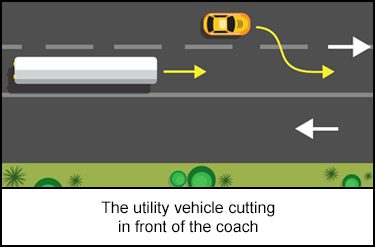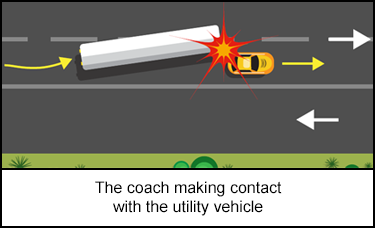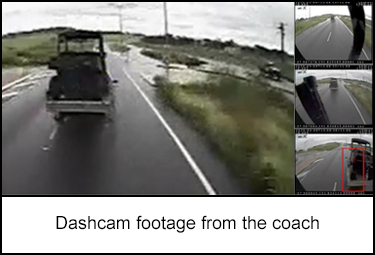-
What happened?
A passenger transportation coach carrying 26 coal seam gas (CSG) industry personnel was travelling on a dual carriage section on a public highway.
The coach had moved into the right hand lane to overtake a utility vehicle carrying a 4x4 off-road style vehicle on its tray.
The utility vehicle moved into the right hand lane and cut in front of the coach. The utility vehicle then slowed unexpectedly.
The coach driver took evasive action by moving into the left hand lane. The coach made contact with the utility vehicle at a speed of approximately 90 km/h (56 mph).
The coach and utility vehicle sustained minor damage. The coach driver, passengers and utility vehicle driver were unharmed.

-
Why did it happen?
The tailgate of the utility vehicle had been lowered, obscuring its traffic indicators and brake lights.
The coach driver was not alerted to the possibility that the utility vehicle might make a right hand turn onto a crossroad or that the utility vehicle may be slowing due to the application of its brakes.

-
What did they learn?
Defensive driving by the coach driver was a contributing factor in limiting the consequences of this collision. The coach driver was rested and had recognised the possibility that the utility vehicle driver may slow without warning. These factors contributed to limiting the incident severity.
Undertake defensive driver training to learn about how to recognise/anticipate unexpected behaviours of other road users and techniques for reacting to avoid incidents.
Drive defensively – recognise/anticipate unexpected behaviours from other road users. Decrease road speed and following distance accordingly
Take regular breaks to ensure that the driver is rested. This increases the driver’s ability to be alert and to anticipate unexpected behaviours from other drivers. Include breaks in journey management plans.

-
Ask yourself or your crew
Have you been involved in a road transport incident or near miss caused by unexpected behaviours from other road users?
What techniques do you use to recognise/identify unexpected behaviours from other road users? How do you respond in these situations?
Are you aware of any spots in your local area where drivers might behave in an unexpected manner (e.g. due to road configuration)?

Add to homescreen
Content name
Select existing category:
Content name
New collection
Edit collection
What happened?
A passenger transportation coach carrying 26 coal seam gas (CSG) industry personnel was travelling on a dual carriage section on a public highway.
The coach had moved into the right hand lane to overtake a utility vehicle carrying a 4x4 off-road style vehicle on its tray.
The utility vehicle moved into the right hand lane and cut in front of the coach. The utility vehicle then slowed unexpectedly.
The coach driver took evasive action by moving into the left hand lane. The coach made contact with the utility vehicle at a speed of approximately 90 km/h (56 mph).
The coach and utility vehicle sustained minor damage. The coach driver, passengers and utility vehicle driver were unharmed.

Why did it happen?
The tailgate of the utility vehicle had been lowered, obscuring its traffic indicators and brake lights.
The coach driver was not alerted to the possibility that the utility vehicle might make a right hand turn onto a crossroad or that the utility vehicle may be slowing due to the application of its brakes.

What did they learn?
Defensive driving by the coach driver was a contributing factor in limiting the consequences of this collision. The coach driver was rested and had recognised the possibility that the utility vehicle driver may slow without warning. These factors contributed to limiting the incident severity.
Undertake defensive driver training to learn about how to recognise/anticipate unexpected behaviours of other road users and techniques for reacting to avoid incidents.
Drive defensively – recognise/anticipate unexpected behaviours from other road users. Decrease road speed and following distance accordingly
Take regular breaks to ensure that the driver is rested. This increases the driver’s ability to be alert and to anticipate unexpected behaviours from other drivers. Include breaks in journey management plans.

Ask yourself or your crew
Have you been involved in a road transport incident or near miss caused by unexpected behaviours from other road users?
What techniques do you use to recognise/identify unexpected behaviours from other road users? How do you respond in these situations?
Are you aware of any spots in your local area where drivers might behave in an unexpected manner (e.g. due to road configuration)?
A coach carrying 26 people was involved in a minor collision with a utility vehicle on a public highway. The coach driver took evasive action attempting to avoid the utility vehicle, resulting in minor damage to both vehicles, but no injuries were reported.
Original material courtesy of Safer Together (Australia)
To access the PDF and PowerPoint versions, please visit https://www.safertogether.com.au/resources/sharing-library/collision-learning-event-bulletin












